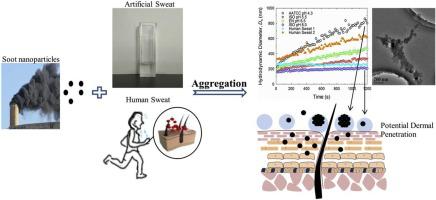Journal of Hazardous Materials ( IF 13.6 ) Pub Date : 2020-08-05 , DOI: 10.1016/j.jhazmat.2020.123614 Jing Li 1 , Xingjian Yang 2 , Zhen Zhang 2 , Harry Xiao 2 , Weimin Sun 3 , Weilin Huang 4 , Yongtao Li 2 , Chengyu Chen 2 , Yan Sun 5

|
Soot nanoparticles (SNPs) are airborne contaminants that could potentially penetrate skin, but their aggregation after contact with sweat may lower their health risks. This study investigated SNP aggregation kinetics in 4 artificial sweat standards and 21 human sweat samples. Effects of sweat inorganic (NaCl, Na2HPO4, and NaH2PO4) and organic (L-histidine, lactic acid, and urea) constituents, pH, temperature, and concentrations were examined. Results showed that SNP aggregation rates in 4 standards followed American Association of Textile Chemists and Colorists (AATCC) > British Standard (EN) > International Standard Organization (ISO) pH 5.5 > ISO pH 8.0, and could be described by the Derjaguin-Landau-Verwey-Overbeek (DLVO) theory. The aggregation rates increased with concentrations of SNPs, inorganic salts, L-histidine, and lactic acid, decreased with increasing pH and concentration of urea, and were weakly influenced by temperature. Systematic characterizations revealed SNP adsorption for organic sweat constituents. SNPs aggregated rapidly to ∼1000 nm in AATCC, but remained stable in ISO pH 8.0 and > 14/21 human sweat fluids over 20 min. The SNP aggregation rates correlated negatively with pH (r = -0.531*) and |ζ potential| (r = -0.464*) of human sweat samples. Sweat evaporation could promote aggregation of SNPs, hence lowering their potential harm via dermal exposure.
中文翻译:

柴油烟灰纳米粒子在人造和人类汗液中的聚集动力学:汗液成分,pH和温度的影响。
烟尘纳米颗粒(SNP)是空气传播的污染物,可能会渗透皮肤,但接触汗液后其聚集会降低其健康风险。这项研究调查了4种人工汗液标准品和21种人类汗液样品中SNP的聚集动力学。无机无机汗液(NaCl,Na 2 HPO 4和NaH 2 PO 4的影响)和有机(L-组氨酸,乳酸和尿素)成分,pH,温度和浓度进行了检查。结果表明,四种标准物中的SNP聚集率遵循美国纺织化学和着色师协会(AATCC)>英国标准(EN)>国际标准组织(ISO)pH 5.5> ISO pH 8.0,并且可以用Derjaguin-Landau- Verwey-Overbeek(DLVO)理论。聚集速率随SNP,无机盐,L-组氨酸和乳酸的浓度增加而增加,随pH和尿素浓度的增加而降低,并且受温度的影响较小。系统表征表明SNP对有机汗液成分的吸附。SNP在AATCC中迅速聚集至约1000 nm,但在20分钟内在ISO pH 8.0和> 14/21人汗液中保持稳定。r = -0.531 *)和| ζ电势| (r = -0.464 *)人汗液样本。汗液蒸发可以促进SNP的聚集,从而降低其通过皮肤暴露的潜在危害。

























 京公网安备 11010802027423号
京公网安备 11010802027423号